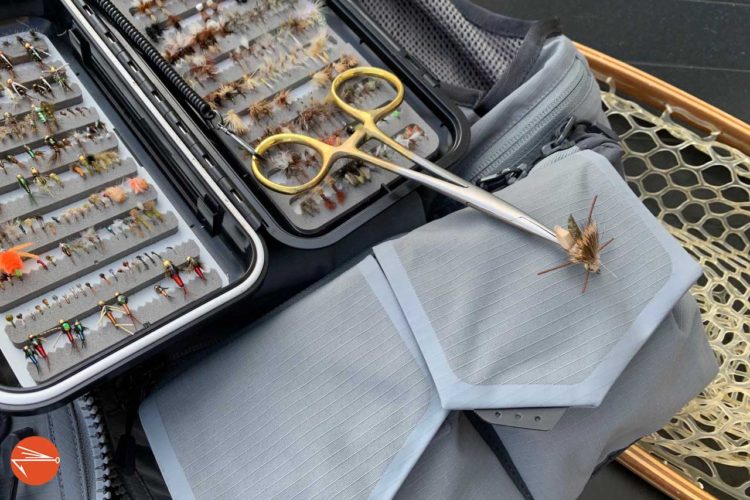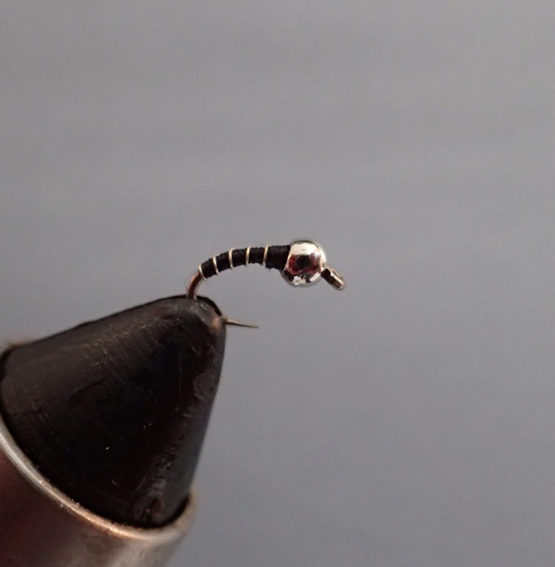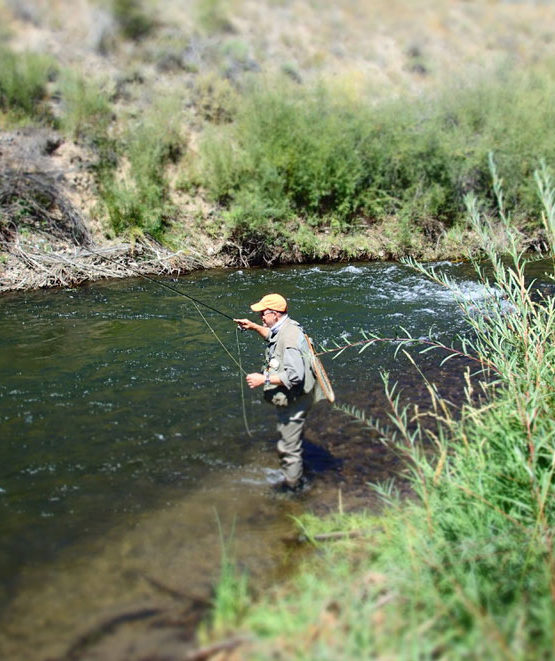Among all the tools in fly fishing, forceps are one of the most essential. But if you’re wondering how they’re used, read on.
If there’s another sport or hobby that employs more dangling, jangling gadgets than fly fishing, I’m all ears. If you think about it, when we whack-job fly fishers find ourselves out in the middle of some raging river, we darn well better have everything we need hanging from our person like a Christmas tree, or we might just find ourselves up a river without a tool. Among the most commonly used gadgets, and one you definitely don’t want to accidentally leave back in your vehicle, is a good pair of forceps. But what are forceps used for in fly fishing?
In short, anglers use forceps to easily and safely remove flies from fish. Additionally, fly fishers use forceps to select flies from their boxes and hold them securely while they tie them to their leader or tippet. With a scissoring mechanism, a needle-nose plier-like snout, and clamping teeth, forceps are an incredibly versatile and useful tool.
I don’t know whose idea it was to start using forceps in fly fishing situations, but it was definitely a stroke of genius. With my brilliant deductive reasoning skills, I’d have to lay my money on a fat-fingered surgeon with a penchant for catching fish on a fly.
I can just see this person, elbow deep in someone’s innards, concentrating on resecting something when, ding, the idea light goes on: wow, these would sure come in handy when I’m fly fishing! Shortly thereafter, he or she has cleared the week’s schedule of remaining surgeries to test a set of hemostatic forceps on a favorite river. The rest, as they say, is history — I mean, if that’s really how it went — and anglers have been using forceps ever since.
If you’re new to fly fishing, thinking of taking it up, or fly fishing without using forceps, this post will not only inform you about the normal and proper uses for them, it may just give you a few ideas about how to use a pair of forceps in ways you might not have considered.
Disclaimer: This post may contain affiliate links, meaning we will receive a small commission (at no cost to you) if you click through and make a purchase.Removing Flies From Fish
Depending upon how well you’ve hooked the fish that is now laying in your net, waiting to be released, you may be able to remove your fly without the use of forceps.
Among all the fish I’ve caught fly fishing over the years, a fairly large percentage of them weren’t hooked very well. In such cases, when I’ve gone to remove my fly, I’ve found that it has either fallen out on its own or is precariously dangling from the filmy membrane around a trout’s mouth. In this case, a quick finger pinch will set it free.
In every other case, I’ve absolutely needed my forceps. Whether my fly has embedded perfectly at the side of a fish’s mandible, deep inside its mouth, or if I’ve foul hooked it somewhere in its outer flesh, I’m quick on my trusty forceps to do the extraction work. Not only does it make the job easier and more efficient, it’s easier on the fish. After all, how would you like it if someone shoved his grubby fingers into your gullet to remove a sharp object that has pierced your tongue?
Given the choice, I think I’d opt for the sleek surgical instrument a hundred times out of a hundred!
Selecting Flies From Fly Boxes
Using forceps to select flies from your fly box is another one of the tool’s primary uses. Using them to browse in this way is especially helpful if you happen to be rummaging through either an overcrowded fly box or one that is home to a lot of furry and feathery terrestrials or streamers. Use the forceps’ tip to move such plumage out of the way so that you can see your fly better and so that, when you grab the one you want, you don’t pull three other flies out with it.
I also like using my forceps when shopping through my tiny fly boxes. When I see the little bugger I want to use, it’s a heckuva lot easier to grab it from my fly box with my forceps’ clamps than with my neanderthal-like fingertips. Using my forceps for this purpose also helps to maintain the integrity of the fly while keeping me from dropping it into the water or riverside reeds below.
Related Posts:
- Fly Fishing With Small Flies (The Complete Guide)
- 21 Common Fly Fishing Mistakes To Avoid
- 10 Baetis Nymph Patterns You Need To Try
- What Is The Best All-Around Fly Rod Weight?
- Do You Need a Strike Indicator? “Naked Nymphing”
- What is A Biot? Tying Flies With Goose And Turkey Biots
Securely Holding Flies While Tying Them On
I can’t tell you how many flies I’ve not lost due to a fumble while tying one to my tippet. If you happen to drop a fly that is well-clamped in the jaws of your forceps — in other words, drop your forceps — the fly will still be there when you pick it up. By the way, for this same purpose, I don’t know a single angler who doesn’t keep his or her forceps tethered.
Removing Flies From Flesh
If you’re new to fly fishing, a certain fate awaits you. You will, at some point not long from now, get a fly embedded in your flesh. I’ve seen (and endured myself) flies stuck barb-deep in fingers, palms, necks, noses, ears, cheeks and, yes, even eyelids. A sharp hook in the flesh is not something you’d hope for and, while there are a variety of effective ways to remove said fly from said flesh, your handy dandy forceps will often play a part.
Now that you’re more familiar with the standard uses of forceps in fly fishing, here are a few more you may not have thought of:
Forceps Make A Great Impromptu Zipper
You’re well into your fly fishing day, when the afternoon wind kicks up, and the rain clouds roll in. It’s time to pull out that rain jacket or windbreaker you’ve had stuffed in its pack a little too long. And, just as soon as you go to pull up the zipper, the slider’s pull tab breaks off. No problem! Just grab your forceps and finish the job.
Use Forceps To Light The Grill
It’s your first night at the cabin. You’re fresh off the water, and it’s been an epic day. The frosty beverages and stories are a-flowin,’ as is the propane to the grill. But, surprise, surprise, the barbecue’s ignitor isn’t working. And not a single member of your group brought one of those extended tube lighters. No worries. A lit match clamped at the end of your forceps and shoved into the ignitor hole ought to do the trick… of lighting the grill, that is, not keeping you from being the idiot who singed his eyebrows off.
Forceps As A Finger Splint
If you’ve gone and sprained or broken your finger while fly fishing, let me first say, dangit! That sucks! I hope it wasn’t on your casting hand! Either way, forceps make a terrific makeshift splint until you can get to a hospital or clinic.
Just place the handle section in your palm and carefully tape the extending section alongside or underneath the affected digit. And then, I say, take a couple of aspirin, and play on! That clinic isn’t going anywhere, and you might just be on the verge of a great hatch!
Forceps To Fish Out The String That Slipped Back Into Your Sweats
Yes there are probably more annoying things in life but, is there anything more annoying than pulling on that favorite sweatshirt only to find that the hood string has retreated six or seven inches back into its little cotton burrow? I hate that! Now, when it happens to me, I don’t sweat it, I just grab my forceps and fish the bashful string back out into the daylight, where it belongs.
Use Forceps To Hold A Nail
When out fly fishing, I don’t often find myself hammering nails. In fact, I don’t believe the two activities have ever converged in my life. That said, I have used my forceps to hold a small nail while I hammer it in. I like my fingertips. I don’t like smashing them with a hammer. Forceps, meet small nail, save Matt’s fingers. I know, I’m an innovator.
To Retrieve Something Dropped In The Toilet
I’d be willing to bet that somewhere in the neighborhood of ninety-five percent of the people reading this post have, at at least one time in their lives, accidentally dropped something important into the toilet. Be it a wedding ring, money, car keys, a microchip containing the nuclear launch codes… something fell into that mysteriously icky abyss that you just couldn’t turn your eyes from and flush away. In the past, you’d have stood over the object, first wishing you could go back in time five seconds to undo your mistake, then, quickly coming to the dreadful realization that you’d probably have to just reach in and grab it with your bare hand, and never, ever, ever tell anyone of this incident.
No more.
If whatever plopped into the commode can wait a minute or two, simply go get your forceps and use them to fish the object out. Problem rectified! However, in the euphoria of having not had to plunge your hand into the yucky toilet water, don’t forget that you’ll now have to go out and get new forceps, and incinerate the set you just defiled.
Posts You Might Also Like:
- What Is A Large-Arbor Fly Reel? Plus 7 Key Advantages
- 7 Best Strike Indicators For Fly Fishing
- How To Tie A Dry Dropper Rig (5 Simple Steps)
- Buying A Fly Rod: 5 Key Considerations
- How Often Should You Clean Your Fly Line?
Clamping It All Down
Clearly, forceps are a fantastic tool for fly fishing and for a variety of other household uses. I hear they come in handy during surgical procedures as well. And, I mean, given all their amazing design attributes, why wouldn’t they?
Now that I think about it, in addition to keeping one tethered to my fly vest, I’m going to start keeping a set of forceps in my tool box and my glove compartment. I think I’ll also start keeping a pair of forceps under the sink in my bathroom! (Shh.. No one has to know why.)
As we often say here at FFF, we only pretend to know everything about fly fishing. It’s not really the case. The truth is, we love hearing from our fans, so please be sure to sign up to receive Fly Fishing Fix in your inbox, and let us know some of your own innovative uses for this ingenious tool.
Tight lines!










